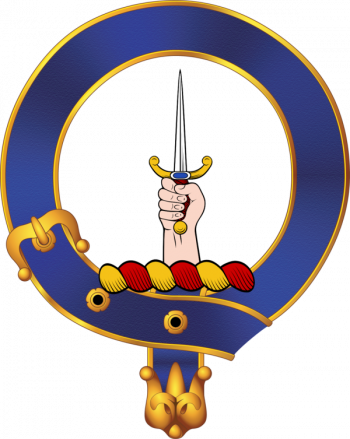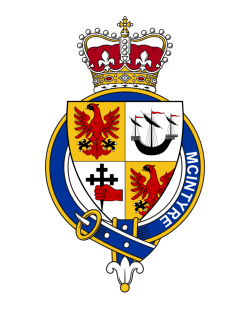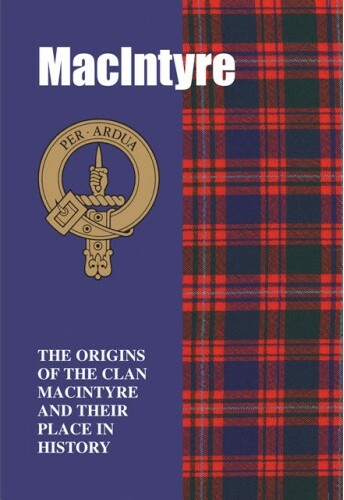
Clan MacIntyre
PER ARDUA –
Clan MacIntyre are a Highland clan. The name translates as "Son of the Carpenter", and the clan's history have long been associated with myth and legend.
Although there are rumours of a "Black Book of Glen Noe" which was said to have contained the history of the clan, no documented MacIntyre records have ever been discovered. They were foresters to the Lords of Lorne and held land at Glen Noe in Argyll for many centuries.
The MacIntyre clan motto is "Per Ardua" (Through Adversity) and the clan crest is a hand holding a dagger.
The Tartans
of Clan MacIntyre
Scottish History
of Clan MacIntyre
Settling scores
The clans have gone now from that rich corner at the east end of Loch Awe, in Argyll, where the MacGregors were once the custodians of the great keep of Kilchurn Castle and where their townships dotted Glen Streae and Glen Orchy, but traces remain among the grass and heather of the hillsides.
The Glen Orchy Campbells, who evolved into the powerful house of Breadalbane, pushed the MacGregors eastwards and also began to impose over-lordship on the clans and families in the area and one of these was the MacIntyres, the clan which produced one of the best nature poets, Duncan Ban MacIntyre (1724-1812), Donnachadh Ban nan Oran, Fair-Duncan-of-the-Songs.
There is a striking, Grecian-style monument to him on a knoll close to the village of Dalmally. It was erected in 1859 and money for it came from Gaelic exiles all over the world.
The Forestry Commission has made a road from close to the village to the foot of the monument and it is a splendid viewpoint over Loch Awe and also over the lower ground and across to the great mountain, Ben Cruachan, Cruachan Beann, the-heaped-up-mountain-of-the-many-tops.
Just to the east of Ben Cruachan’s strung out mass lie two other prominent peaks, Beinn Eunaich (Fowling Mountain) and Beinn a’ Chochuill (of the hood or shell). Between them and Ben Cruachan lies a sloping glen and a prominent burn.
The landscape in much of the area has changed from past centuries with much, ugly, conifer forestry, with lines of pylons and a metalled track running up the east side of this glen and which is linked to modern hydro electric schemes.
The crest of the bealach or pass lies just beyond the end of this hydro road and a little line of poles runs up and over the crest.
In this corner of the upper glen, below the crest of the pass and close to the end of this hydro ‘road’, lies a large boulder which has been partly split in two by the action of frost and ice and many winter storms. It is flattish in shape and has the look of a table.
In fact, it was used as such once a year by the MacIntyres in special ceremonies whose roots go back into the centuries and which emphasises the special significance given to the colour white long ago.
It meant guardianship, protection and security and it may be why the MacIntyres plant badge is white heather (although some sources only say heather).
Plant badges of the clans were not, of course, for identification as is often said, but were talismans and meant something special. In the MacIntyres case white was indeed very special, as we shall see shortly.
In Gaelic the name MacIntyre is rendered Mac an t-Saoir, meaning Son of the Carpenter. There is a strong tradition which says that Olaf the Red, King of (the island of) Man and Somerled, Thane of Argyll, were sailing in their galleys near to one another on a raiding foray.
Somerled had earlier asked for the hand of Olaf’s daughter in marriage, but Oaf refused. Somerled’s nephew, Maurice MacNaill sailed in Olaf’s galley and he decided to give his uncle a helping hand. Maurice secretly bored a number of holes in Olaf’s galley that night as the two craft lay side by side at anchor and overlaid the holes with tallow and butter.
The next day the galleys sailed south from the island of Skye, where they had been moored and when off the long peninsula of Ardnamurchan, Olaf’s galley began to sink.
Olaf called to Somerled for help, but Somerled said he would only assist him on condition that he was given the hand in marriage of Olaf’s daughter.
Olaf at first refused, but as the water began to lap about his ankles and finding himself in great peril he gave his consent. Somerled then gleefully helped him to leave his sinking ship and to clamber to safety aboard Somerled’s galley.
When Olaf could no longer see what was happening on his own galley, Maurice MacNiall quickly plugged the holes with wooden pins he had in readiness. Olaf’s galley was saved and from that day Maurice MacNiall was known as An t-Saoir, the Carpenter, and his descendants as Mac an t-Saoir, Son of the Carpenter.
The great Highland historian, writer and naturalist, the late Seton Gordon, wrote that the MacIntyres came to Loch Etive around the 14th century.
There was a Gaelic saying, “The two oldest farmers in Alba (Scotland) are the apple tree which grows on the shore of Loch Etive and MacIntyre of Glen Noe”.
Glen Noe (Nodha), means the new glen, and partly connects Loch Etive and the east end of Loch Awe by means of the main pass where the flat stone stands and which is called the Lairig Nodha, the New Pass.
An old legend has it that the original home of the MacIntyres might have been in the Hebrides. One tradition favours Skye, anoher the island of Islay (pronounced eye-la) and another (less strong) the peninsula of Kintyre.
The clan went walkabout, as the Australians say, and when they approached Ben Cruachan from the south-west and driving their cattle with them – a tale which gives evidence to Islay as the place of origin – they met a Spectre called the Spirit of Cruachan.
This mountain long ago was thought to be the home of witches and spectral beings and its twin peaks were ‘looked to’ by kings and leaders from the rock-fortress of Dunadd, near the modern Crinan Canal and south of Oban, the cradle of Scotland.
The Spirit of Cruachan barred their way to test their courage and when she was satisfied with the MacIntyres bravery she became friendly and guided them to the most suitable passes. The Spirit told them that they were to make their new home where a white cow in their herd, and which they treasured as a sacred beast, would lie down after the crossing of the Lairig Nodha.
They did so, possibly in the autumn, and they struck strong winds and harsh terrain.
It must have been a great joy for them the see the green shores of Loch Etive below them and fringing oak, birch and alder woods in the lower glen. They descended towards the loch shore and about half a mile away from the water the white cow lay down.
The MacIntyres set up home there and prospered for five centuries.
About this time King Robert the Bruce was fighting for the throne of Scotland and had defeated the MacDougalls in the Pass of Brander which runs alongside loch Awe.
The MacDougalls lost their lands and area-control to the Stewarts who had aided Bruce. The MacIntyres became ‘foresters’ to the Stewarts and at a later date to the Campbells.
(The word ‘forester’ is more like our modern game wardens: they controlled the hunting of red deer. The words deer forest have nothing to do with trees, but are a corruption of Latin for the land-outwith-the-enclosure.)
The MacIntyres held Glen Noe on a tenant basis from the Campbells of Inverawe and the flat stone near the crest of the Lairig Nodha was of great symbolic importance.
At midsummer a snowball was brought from a corrie (hollow) on Ben Cruachan, known as the Snowy Corry, Cor’ an t-Sneachda, and brought to the stone.
A white calf was handed over with ceremony to the Campbells and a kind of barbecue was held at this stone, called the Stone-of-the-Fatted-Calf, Clach an Laoigh Bhaita. The MacIntyres paid their rent in the normal way by supplying men-at-arms or meal or money, but the snowball was a sign of their security of tenure.
In the graveyard of Ardchattan priory, on the shores of Loch Etive, are the graves of some of the MacIntyre chiefs and one has a round carving on it like a ball or orb and this may commemorate the snowball ceremony.
But this old custom was all to go sour. The Campbells gradually increased the money rent until, in time, the MacIntyres could no longer pay it and they left Glen Noe in the early 1890s.
Not a lot is known about the MacIntyre chiefs. It is known that one of them, Duncan, married Mary, daughter of Patrick Campbell of Barcaldine. James, the bard chief, born in 1727, and described in old documents as Seumas Mac an t-Saoir, Fear a Ghleinne Nodha, became an excellent Gaelic scholar and was helped in his education by the Earl of Breadalbane. He wrote many verses sending up Dr. Samuel Johnson because that ponderous literary figure said the Highlanders were a rude barbarous people.
The chief was visited by Duncan Ban MacIntyre who wrote a poem about his visit to Glen Noe and who described the MacIntyres great seal which had eagles displaying wings and a ship with sails. The chief died in 1799 and his wife lived to an age of 103.
When the old days in Glen Noe and Loch Etive-side came to an end and the last MacIntyres emigrated to the United States they preserved the clan’s armorial great seal, signet ring and quaffing cup.
In 1955 Alasdair MacIntyre of Camus-na-h-Einidh recorded arms in the Lyon Court, Scotland’s court for heraldic matters, as cadet of the chiefly house of MacIntyre.
The shield was different from that which some clan historians believed to be correct and in 1991 James Wallace MacIntyre of Glen Noe, ninth of the recorded chiefs, matriculated the correct ‘undifferenced arms’.
Tales and legend
The MacIntyres got around. A branch is sometimes recorded as a sept of the Campbells of Craignish. MacIntyre in Badenoch are descended from the bard whom William, 13th of Mackintosh, took under his protection in 1496.
A family of MacIntyres were hereditary pipers to MacDonald of Clan Ranald and the MacIntyres of Rannoch were hereditary pipers to the chief of Clan Menzies.
A branch of the clan resident in Cladich, near Loch Awe, were renowned for their weaving of hose (stockings) and garters.
A sept of Glen Noe settled at Camus na-h-Eiridh, probably during the 15th century, and is regarded by many as the most ancient of the cadet branches.
Although the MacIntyres were under Campbell over-lordship many of them joined the army of James Graham, Marquis of Montrose, and his redoubtable second in command, that great soldier Alasdair MacColla, the warleader of Clan Donald, in their bid to win Scotland for Charles I.
The 17th century wars of the Covenant are complex events with links to England and Ireland and involving both religious and political issues.
Alasdair MacColla was also striving to ensure Clan Donald held onto the Headship of the Gael in the face of the expansionist Campbells. He also fought for the Roman Catholic cause against the mainly Presbyterian alliance, the Solemn League and Covenant, and he was the greatest of the sword-and-buckler men and the Achilles of the Gael.
The royal army burned all houses in Campbell terrain, but the MacIntyres were left untouched because of ancient links with Clan Donald.
There is an evocative picture of a deer belling (roaring) in Glen Noe in author Neil Munro’s historical novel, “John Splended”, which tells of these wars.
He describes the mainly Campbell army sleeping in Glen Noe on their way north to try and trap Montrose and Alasdair MacColla, but who were to be routed in the terrible defeat at Inverlochy, near modern Fort William, in 1645.
One or two MacIntyres were present on the Campbell side possibly to guard against changes in fortunes.
The chief’s piper joined Montrose’s army with some clansmen, but the chief himself was with the Duke of Argyll at Inverlochy. He must have regretted it.
Seton Gordon states that the MacIntyres once possessed ancient manuscripts about the House of Uisneach (pronounced wish-na) who were linked to one of the oldest sagas in Scotland and Ireland and who heroes and heroine had lived beside Loch Etive.
The old tale comes in several versions and was once known from Barra to Cowal and a lovely song exists called ‘Deirdre’s Farewell to Scotland’ in which the verses tell of her longing in exile for the glens, Glen Massan, Glen Da Rua (modern Glendaruel) and Glen Etive.
Deirdre was the Celtic Helen and was reputed to be one of the loveliest women in the world. Her name means Drop of Dew and should be pronounced jeer-dre, but hardly ever is.
A mainstream version of the old story was that Deirdre was brought up at the court of king Conochbar or Cormac in Ireland. The king desired her, but she did not reciprocate his feelings. She was reputed to be a Child of Destiny and would play a part in bringing down the House of King of Ulster.
Deirdre fell in love with a warrior called Naoise (pronounced noy-sha), of the House of Uisneach, and the lovers fled to Scotland along with Naoise’s brothers, Aluinn and Ardan, and they lived a life of Golden Age joy in the Scottish glens.
They had a bower in Glen Etive, probably near Dalness, and its walls were covered in the down of birds and its floors in deer hides and it was possible to catch salmon from its windows because it was sited close to deep pools in the Highland river.
The story is commemorated in several place names in Scotland. Loch Ness may take its name from Naoise.
King Cormac sent a mutual friend, Fergus, to Scotland and he persuaded the lovers to return to Ireland where they were promised safety.
There is a stone in Aird’s Bay, near Taynuilt, called the Stone of Farewell, which is reputed to mark the spot where the royal barge carried Fergus, Naoise and Deirdre back to Ireland.
Naoise was then killed by the vengeful King Cormac. Deirdre either committed suicide or was also killed. Her death meant that tribal fighting broke out and eventually brought about the fall of the House of Ulster, thus fulfilling the prophecy.
If the MacIntyres did indeed possess these ancient manuscripts, as Seton Gordon claims, then their loss is grievous indeed.
Family History Mini Book
We hope you enjoyed reading this excerpt from this mini book on the Scottish history of the MacIntyre family.
You can buy the full book for only121 Clan MacIntyre
Tartan Products
The Crests
of Clan MacIntyre











































































